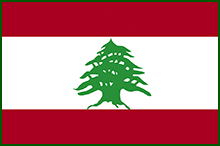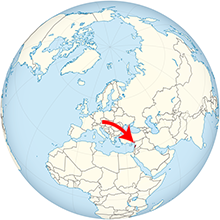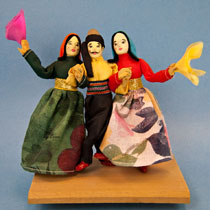Description of Figure/Doll
Three Lebanon figures performing a folk dance. These dolls have ceramic heads, stuffed torsos, and rubber-covered wire extremities. The all have hand painted faces and red wooden boots. The women on either end of the dance have black yarn for hair and are holding colorful kerchiefs as they dance. The women are wearing scarves, long skirts, and gold ribbons for a belts. The man has a Lebanese hat and long black pants.
Link to higher resolution images at ClipPix
Lebanon
Location: Middle East
Capital: Beirut
Main language: Arabic
Currency: Lebanese pound
Figure/Doll
Construction: ceramic, wire, cloth
Height in Centimeters: 15
Height in Inches: 6


Lebanon: Dabke National Dance of Help and Assistance
Reading Level: 5.97
My name is Aman and I am 13 years old. I live in a small mountain village in Lebanon. My country is located in Middle East. The language we speak is Arabic, and most of the people are Muslim.
We live a very simple life. Most of us do not have cars, television sets or Internet access. In fact, many still use horses, donkeys and mules for farming and transportation. Even so, I would never trade my life and move to a big city, like Beirut. It’s wonderful to see the way people in small Lebanese villages help each other.
For example, some of our homes still have roofs that are made of dirt, clay, branches and straw. When the weather changes, the roofs often crack and leak. At that point, all we have to do is ask and our neighbors will come to help. Nowadays, they may bring a stone roller, called a Mahdaleh. In previous times, they would merely form a line and stomp on the roof to adjust the mud. In fact, this process was the origin of our national dance, called the Dabke.
The Dabke dance and music are also referred to as Al Awneh, Dal’ouna and Daloona. Men and women of all ages participate. They hold hands, form an arc, and move to the rhythm of the music. There is usually a leader (called a Lawweeh) who sets the pace. The Dabke is performed at every festival throughout Lebanon. It has a lot to do with unity and aid, with everyone holding hands and moving in one direction.
The community spirit in my village goes beyond fixing roofs. Last year my grandfather decided to build a new barn. When his neighbors heard of the plan, all of the men of the village came to help. While the men are building the barn, the women did the cooking. They made Kibbeh (a delicious dish with wheat and lamb) and served it with bread.
The harvest season also involves cooperation. It is wonderful to see the townsfolk together picking fruits and vegetables. In fact, to refuse a helping hand is very rare in our village. If someone arrives at meal time, you can be certain he or she will eating at your table.
I recall one night, not too long ago, a stranger arrived at our door asking for some food. My parents not only offered him food, they told him that he could stay the night. Even though we aren’t rich or have modern technology, I would not trade my life. I like living in a place where the entire village is considered family.




